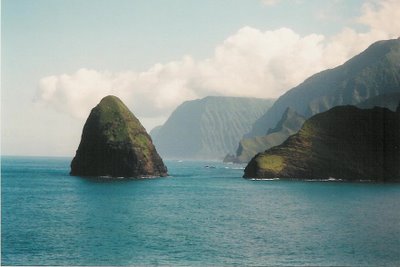Book on Leprosy Settlement Draws Fire
By MICHAEL WILSON
HONOLULU, March 23 — A new book about a dark chapter in Hawaiian history, when thousands of people with leprosy were forced to live on a remote outcropping of the island of Molokai, has upset some former patients of the settlement and raised delicate questions about how much deference should be paid to them.
Emilia came upon this article in today's New York Times. We both found it curious that the cover of John Tayman's The Colony doesn't even have a picture from Hawai'i on it. Rather, it " depicts a section of the Amalfi Coast in Italy." According to Tayman, "There were various covers that were under consideration ... Some of them were illustrations and paintings, some were photographs. This is a representative cliff. I think it's an arresting and beautiful image."
We see this (mis?)representative cover as a missed opportunity to capture the evocative and unique essence of Kalaupapa. The imposing sea cliffs of Moloka'i's north shore (where Kalaupapa is located) are the tallest in the world. In fact, that was the very reason for the establishment of this settlement – its remote inaccessibility. With its choppy and shark-infested waters providing no safe landing, Kalaupapa is a far cry from the serene Mediterranean Amalfi coast.
Perhaps, a more suitable photograph for the cover of Tayman's book might have been this one, taken by Emilia on our 2004 trip to Kalaupapa: 
Interested in finding out how to get to Kalaupapa or anywhere else off Hawai'i's beaten track? Let WePlanYourTrip help with the details. Simply contact us. We will be more than happy to assist with your trip planning and travel research.
No comments:
Post a Comment